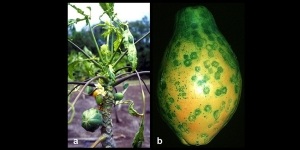
Virus resistance breaks down in Chinese GM papaya
by GMWatch.org [1]
Ringspot virus-resistant GM papayas are often cited as a genetic engineering success. But a new study (abstract below) reports that in China, the virus resistance in GM papaya has broken down under pressure from a new lineage of the virus.
The study reports that the GM virus-resistant papaya planted in Hawaii retains its virus resistance. But this has not saved the Hawaiian papaya industry, since many countries don’t want [2] GM papaya and up to a third of the crop is thrown away because it’s bruised or mis-shapen. As a result, USDA scientists have been looking [2] at ways to make the unwanted GM papayas into biofuel.
In addition, a non-GM virus-resistant papaya has been developed [3], suggesting that the GM version is not needed.
—
Characterization of Papaya ringspot virus isolates infecting transgenic papaya ‘Huanong No. 1’ in South China
Wu, Z., Mo, C., Zhang, S., & Li, H. (2018). Scientific Reports, 8(1), 8206.
https://www.nature.com/articles/s41598-018-26596-x [4]
Abstract
In 2006, the release and cultivation of the genetically modified papaya cultivar ‘Huanong No.1’ successfully controlled the destructive papaya ringspot disease caused by Papaya ringspot virus (PRSV) in South China. However, some transgenic papaya plants from Guangdong and Hainan are found infected by PRSV. In this study, Field investigation was carried out and susceptible transgenic papaya samples were collected during 2012–2016. Twenty representative isolates were artificially inoculated into Cucurbita pepo and commercialised ‘Huanong No.1’ papaya, and results indicated that the plants showed obvious disease symptoms. Phylogenetic analysis of CP genes of 120 PRSV-infected isolates showed that PRSV can be divided into three groups. Isolates from Guangdong and Hainan belong to Group III, which is further divided into two subgroups. The isolates collected in this study have greatly diverged from the previously reported dominant strains Ys, Vb and Sm in South China, indicating that they belong to a new lineage. Further analysis showed a highly genetic differentiation between isolates, and 27.1% of the isolates were identified as recombinants on the basis of CP nucleotide sequences. These results indicate that the genetic variation of PRSV and the formation of the new virus lineage may explain the loss of transgenic papaya resistance in South China.

